
God Bless America!
THIS IS INSANE!! BTN!
You could also call it "Thinking WAAAAYYYYY outside the box!"
There is now a VERSION 2.0 of this thing! Scroll down to see it. :)
| WHAT IS THIS?? (V1.0) |
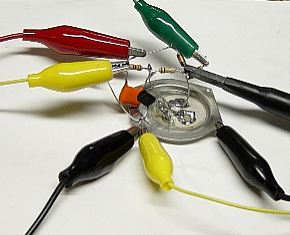 |
(Click pic for large, labeled version.)
THIS THING is an AM TRANSMITTER! Believe it or not... as God is my witness, this thing was a WORKING, x-tal stable, flea-power, AM Transmitter! (This has gotta be THE most UNORTHODOX AM transmitter ever!)
Don't believe me? Well, there are some actual O'scope images, below! What is it??? It is the x-tal transducer "beeper" from a digital wristwatch! Yes, indeed, it DOES oscillate, as long as you can isolate a portion of the x-tal to give you feedback to the base. A dremel tool with an engraving tip will work, as will very careful use of a soldering iron. You simply need to etch a straight line across about 1/4'th of the circular area of metal plating, so you end up with two electrically isolated sections. The 25% section feeds the base, the 75% section feeds the collector. The watch back, itself, is gnd.
If you fed the DC into the 1K resistor (instead of connecting to an antenna) the x-tal would oscillate anywhere between about 5-15Khz. (I later measured the frequency, it was close to 8Khz.) Yes, it is quite shrill! By using a small choke (about 50uh) to feed the collector, it wants to oscillate at RF. This particular x-tal ran at about 548 Khz, low on the AM B'cast band. A standard AM radio picked up the signal loud and clear up to several feet away. AMAZING... and I could hardly believe it myself! This is why I am documenting this insanity here on the Web! (You can't make this stuff up - truth is stranger than fiction! Here's living proof!)
This is, without a doubt ***INSANE*** BTN!!! Who would have EVER even CONCEIVED of such a thing? Well, that is part of the fun of BTN! Doing something totally off-the-wall like THIS! Using something in ways the engineers NEVER intended or even imagined. Ya just gotta LOVE it!!
I did little more tinkering: By changing the coil and putting a variable capacitor across it, I was able to tune this thing through a number of distinct resonances. It was very stable at each one, and could be adjusted a few hundred Hz each way from each center. I didn't have time to fully document things, before it stopped working. I just wanted to get this page online, so others could see what applying a little BTN can accomplish! ;)
| Schematic! (V1.0) |
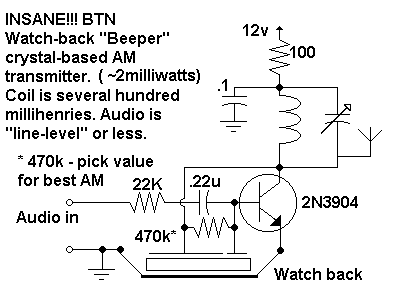 |
The watch back x-tal is the heart of this thing. The variable cap can be just about anything, and the coil value is not terribly critical. (220uH is usually good for the AM Band) Any combo that will put you into the low end of the AM band should work. The audio input level will need to be adjusted for best modulation. The 470K base resistor can be almost any value between 100K to a meg. It needs to be picked to give best AM linearity. (This will vary, depending on the transistor AND the x-tal!) The 100ohm resistor may need to be even less, or omitted, entirely. Just be careful not to "pop" the transistor with too much current!
Because these x-tals were NEVER MEANT to operate like this, they are unpredictable. Plus the fact that you will be etching the conductive surface into two separate parts is another wild variable! You may end up with a unit that fails to oscillate at all. Don't give up... find another dead watch, and try again! ;)
The antenna should be only a few feet (less than 1 Meter) of wire. To connect to something larger will likely stop the oscillation. You can experiment by putting a 1K or 470 ohm R in series with a longer wire. The range is quite short, naturally, but the audio can be VERY GOOD! (Mine was!)
| Actual O'Scope trace! (V1.0) |
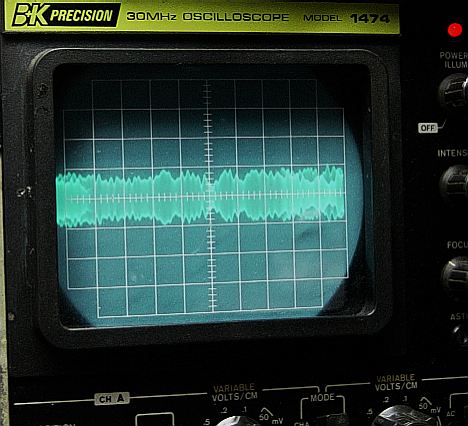 |
This is a digital camera shot of the actual RF envelope being generated by this crazy INSANE BTN transmitter! (It appears "folded" on the edges because the digital shutter caught part of 2 other traces.) As you can see, this is a very clean AM carrier! On the radio, it sounds perfectly sharp and clear! Modulation is somewhat critical, because over-driving it will cause it to stop oscillating for a few microseconds on each negative audio peak. Careful AGC and setting the level yields a very stable RF envelope, as you can see here and in another shot, below:
| Another O'scope trace (V1.0) |
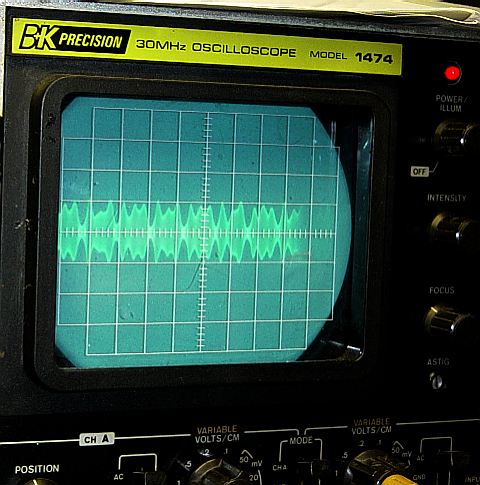 |
The proof is in the pictures! ;) This is coming from a wristwatch back cover's transducer x-tal! I even showed my wife... and brought a radio over for her to hear it! She just smiled. She knows... I'm hopeless! ;)
Since these experiments, I have been busy with other, much more practical & useful projects. This one is pretty much on the shelf. It was fun, that's for sure! (If I tinker with it again in the future, I'll post about it!) Meanwhile, please, continue browsing the rest of the site! :)
V1.0 is DEAD...but not forgotten! ;)
When I tried to fire up V1.0 again, it was no-go. The transistor was good, but no oscillation.
I do have plans to actually put something like this on the air, if at all possible! If I can get another dead watch transducer to generate a signal on or near 3880, I will feed it through the B.O.B. JR transmitter and see if it is enough for anyone to hear me. :) Theoretically, I SHOULD be able to get at LEAST a watt or two! :) But, I haven't tinkered with this in several years. Time allowing, I still may.
V2.0 UPDATE: 3/03/08
IT WAS ALIVE AGAIN, briefly... as V2.0!
With a brand new watch beeper crystal, I decided to try again! That time, I used a 2N5089 transistor, and it worked extremely well! SO WELL, in fact, that I documented it here, and called it Version 2.0! (This x-tal came from another watch that died.)
| BTN AM tx V2.0 |
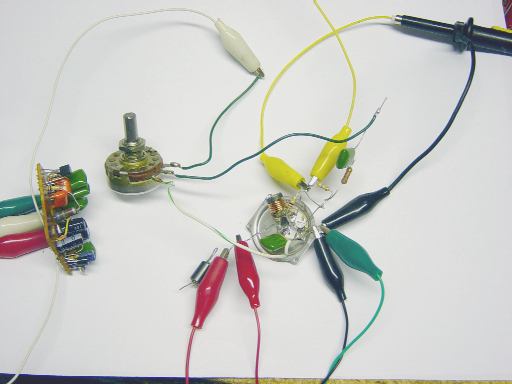 |
(Click pic for large, labeled version with schematic.)
In this one, I added a pot for a modulation control. Besides that, this one is MUCH better than the first! I get about 80% "perfect" sinewave modulation before the positive peaks start to flatten a little. The negative can go right down to ALMOST -100%, without the circuit breaking out of oscillation! It sounds REALLY CLEAN on the AM radio, also! (This new unit oscillates at 581Khz.)
Here is a scope photo of the sinewave audio signal at about 80% modulation:
| O'scope trace, V2.0, sinewave |
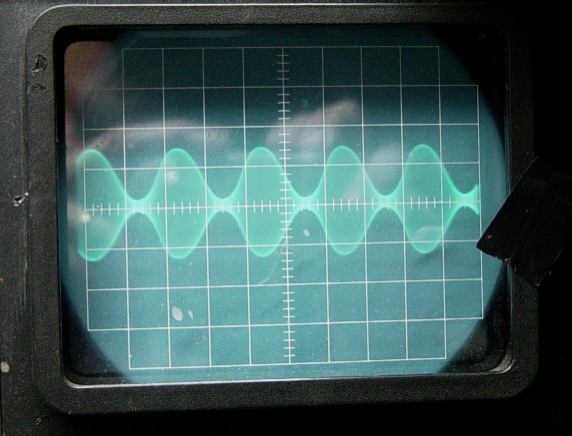 |
Here's a scope trace with music playing through it:
| O'scope trace, V2.0, music |
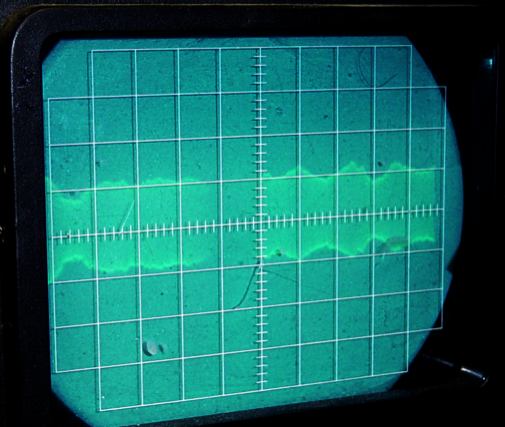 |
So, there it is! The second version! I get the feeling that none of these x-tals are going to oscillate anywhere near the HAM bands, so you may not get to hear me use one on the air.
SITE UPDATED: 6/24/07, 3/3/08, 11/21/23
RETURN TO HOME PAGE





